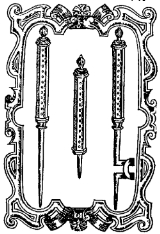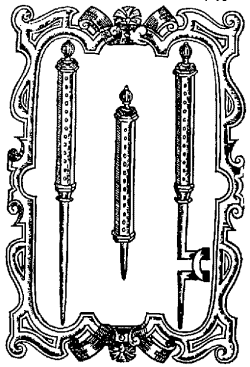
Pricking
Encyclopedia
This article is about the 16th and 17th century practice of 'pricking' witches. For other uses of the word, see prick
.
 During the height of the witch trials of the 16th and 17th centuries, common belief held that a witch
During the height of the witch trials of the 16th and 17th centuries, common belief held that a witch
could be discovered through the process of pricking their skin with needles
, pin
s and bodkins - daggerlike instruments for drawing ribbons through hems or punching holes in cloth.
This practice derived from the belief that all witches and sorcerers
bore a witch's mark
that would not feel pain or bleed when pricked. The mark alone was not enough to convict
a person, but did add to the evidence
. Pricking was common practice throughout Europe
, but was most prevalent in England
and Scotland
. Professional witch finders
earned a good living from unmasking witches, traveling from town to town to perform their services. Hollow wooden handles and retractable points have been saved from these finders, which would give the appearance of an accused witch's flesh being penetrated to the hilt without mark, blood, or pain. Other specially designed needles have been found with a sharp end and a blunt end. Through sleight of hand
, the sharp end could be used on "normal" flesh, drawing blood and causing pain, a process which appeared to mount further evidence against the accused, while the dull end would be used on a supposed witch's mark.
Prick
Prick may refer to:* Prick , style of marking tool* Goad, a synonym in an agricultural sense* Prick * Fingerprick, wound for blood sample* Prick, slang term for penis or inconsiderate person- Titled expressive works :...
.

Witchcraft
Witchcraft, in historical, anthropological, religious, and mythological contexts, is the alleged use of supernatural or magical powers. A witch is a practitioner of witchcraft...
could be discovered through the process of pricking their skin with needles
Sewing needle
A sewing needle is a long slender tool with a pointed tip. The first needles were made of bone or wood; modern ones are manufactured from high carbon steel wire, nickel- or 18K gold plated for corrosion resistance. The highest quality embroidery needles are plated with two-thirds platinum and...
, pin
Pin
A pin is a device used for fastening objects or material together.Pin may also refer to:* Award pin, a small piece of metal or plastic with a pin attached given as an award for some achievement...
s and bodkins - daggerlike instruments for drawing ribbons through hems or punching holes in cloth.
This practice derived from the belief that all witches and sorcerers
Magic (paranormal)
Magic is the claimed art of manipulating aspects of reality either by supernatural means or through knowledge of occult laws unknown to science. It is in contrast to science, in that science does not accept anything not subject to either direct or indirect observation, and subject to logical...
bore a witch's mark
Witches' mark
According to witch-hunters during the height of the witch trials , the witches’ mark indicated that an individual was a witch. The witches' mark and the devil's mark are all terms applied to essentially the same mark. The beliefs about the mark differ depending on the trial location and the...
that would not feel pain or bleed when pricked. The mark alone was not enough to convict
Convict
A convict is "a person found guilty of a crime and sentenced by a court" or "a person serving a sentence in prison", sometimes referred to in slang as simply a "con". Convicts are often called prisoners or inmates. Persons convicted and sentenced to non-custodial sentences often are not termed...
a person, but did add to the evidence
Evidence (law)
The law of evidence encompasses the rules and legal principles that govern the proof of facts in a legal proceeding. These rules determine what evidence can be considered by the trier of fact in reaching its decision and, sometimes, the weight that may be given to that evidence...
. Pricking was common practice throughout Europe
Europe
Europe is, by convention, one of the world's seven continents. Comprising the westernmost peninsula of Eurasia, Europe is generally 'divided' from Asia to its east by the watershed divides of the Ural and Caucasus Mountains, the Ural River, the Caspian and Black Seas, and the waterways connecting...
, but was most prevalent in England
England
England is a country that is part of the United Kingdom. It shares land borders with Scotland to the north and Wales to the west; the Irish Sea is to the north west, the Celtic Sea to the south west, with the North Sea to the east and the English Channel to the south separating it from continental...
and Scotland
Scotland
Scotland is a country that is part of the United Kingdom. Occupying the northern third of the island of Great Britain, it shares a border with England to the south and is bounded by the North Sea to the east, the Atlantic Ocean to the north and west, and the North Channel and Irish Sea to the...
. Professional witch finders
Witch-hunt
A witch-hunt is a search for witches or evidence of witchcraft, often involving moral panic, mass hysteria and lynching, but in historical instances also legally sanctioned and involving official witchcraft trials...
earned a good living from unmasking witches, traveling from town to town to perform their services. Hollow wooden handles and retractable points have been saved from these finders, which would give the appearance of an accused witch's flesh being penetrated to the hilt without mark, blood, or pain. Other specially designed needles have been found with a sharp end and a blunt end. Through sleight of hand
Sleight of hand
Sleight of hand, also known as prestidigitation or legerdemain, is the set of techniques used by a magician to manipulate objects such as cards and coins secretly....
, the sharp end could be used on "normal" flesh, drawing blood and causing pain, a process which appeared to mount further evidence against the accused, while the dull end would be used on a supposed witch's mark.
Bibliographic Sources
- Brian P. Levack, The Witch-Hunt in Early Modern Europe (2nd edn., 1995)
- Gary K. Waite, Heresy, Magic, and Witchcraft in Early Modern Europe (2003)
- Robert W. Thurston, The Witch Hunts: A History of the Witch Persecutions in Europe and North America, 2nd ed. (2007)
- Joseph Klaits, Servants of Satan: the Age of the Witch Hunts (1985)
- Geoffrey R. Quaife, Godly Zeal and Furious Rage: the Witch in Early Modern Europe (1987)

